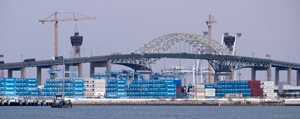Port officials and leaders of supply chain companies, who have long lamented a lack of coordination in the sharing of maritime shipping data as a key factor in inefficiencies plaguing cargo movement through the Port of Los Angeles, have begun testing a centralized database to streamline information distribution, the first such digitized shipping data portal in the United States.
The system has the potential to reduce turnaround time for trucks moving cargo to and from terminals, decrease traffic congestion, cut carbon emissions, and generally improve efficiency at the nation’s largest port.
The current workflow problems often start with chassis providers, without which trucks would be unable to move cargo containers once they come off ships.
“Right now, we get our information in a piecemeal way from the terminals,” said Kristy Schiller, logistics manager at chassis provider Flexi-Van. “Some terminals provide information a day or two before, on the day of, and the day after cargo has arrived, making it difficult to plan for chassis availability and repositioning.”
Kenilworth, N.J.-based Flexi-Van is part of a Pool of Pools agreement that makes it and two other companies, Direct ChassisLink Inc. and Trac Intermodal, the largest providers of chassis for carrying cargo containers at the twin ports. Together, the companies supply 72,000 of the ports’ 85,000 chassis.
The port partnered with GE Transportation Co. to create the program, paying GE up to $1.3 million in a one-year contract to develop the database and web portal, according to port documents. GE is also contributing funds to the program, though the company wouldn’t disclose the amount.
The pilot rollout is at Danish carrier Maersk Line’s APM Terminals, and will include vessels from Maersk and Swiss carrier Mediterranean Shipping Co. Retailers including Home Depot Inc. and Lowe’s Cos. Inc. are taking part in the program as well.
If the pilot program, which launched in mid-May, is successful, chassis and trucking companies would have access to a digital portal that contains information on what time a liner will arrive, what terminal it will unload cargo at, and the size of the containers. This information would allow those companies to plan for proper chassis size, among other details, up to two weeks in advance.
“This will give us much more time to plan ahead and will make a big difference in our operations,” Flexi-Van’s Schiller said.
Digitizing data
The idea to digitize port data took off two years ago when the port received its first super carrier, with a capacity of 18,000 containers, called 20-foot equivalent units or TEUs, said Chris Chase, marketing manager at the port.
The Benjamin Franklin, owned by French shipping company CMA CGM, was the largest container vessel to call at a North American port when it docked in December 2015, and was about one-third larger than the biggest ships that called there at the time.
“We prepared as best as we could, but there were multiple layers to go through to get information,” he said. “Some of the issues that came out of this on the national level led to the question of possibly creating one user-interface portal instead of the usual pen and paper method.”
Individual parts of the port supply chain had already adopted digital processes for tracking data – terminals had operating systems, trucking lines used apps, railroad companies digitized their information – but there wasn’t a system to connect information from all of the players together.
“It’s really wherein all of these data from different stakeholders meet that you kind of have a black hole, if you will, of digitization, and that’s what this solution is looking to solve,” said Jennifer Schopfer, vice president of GE.
Chase called it a one-stop shop, where log-in credentials will be vetted. It should help Flexi-Van’s Schiller by letting her know where to provide chassis, what size, and how many.
“Right now, we’re tracking information in many different ways, from other digital systems, and some on paper that turn into lots of Excel spreadsheets,” Schiller said.
Security risks
While operating systems are being streamlined, ensuring cybersecurity could be a concern, said Nathaniel Gleicher, head of cybersecurity strategy at Sunnyvale web security firm Illumio.
“Whenever we have different systems speaking with each other, it creates opportunities for lateral movement breaches,” said Gleicher, a former director of cybersecurity policy for the National Security Council in the Obama administration.
With the port and GE testing a portal that contains important data, cybersecurity can be strengthened by using strong passwords, ensuring no single party has access to the complete database, encrypting data when not in use, and periodically patching up the system, he said.
“These things tend to be harder to do on a large scale and in big systems,” he said.
GE’s Schopfer, said the company created a portal with the highest level of security in mind.
“From a user’s perspective, the portal access will be on a need-to-know basis,” Chase said.
For example, a freight owner will have access to information relevant to its inventory only, with no access to data on another company’s cargo, he said.
Results from the pilot program are expected in mid-July.
“Right now, the pilot is at one terminal, and assuming success, we will consider expanding this to some or all of our other terminals,” said port spokesman Philip Sanfield.
If successful, the system could give the port a competitive edge.
“This program is customized to the Port of Los Angeles, and if successful, there will be a possibility to scale up to other ports in the country,” said Nick Vyas, executive director at the Center for Global Supply Chain Management at USC.

